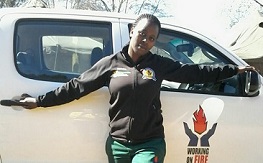People
Fighting fire with motherly instincts
The beginning
Ngqawani started off as a firefighter in July 2005. "There was a recruitment. I went for it, did the training and passed. I was 19 years old then." She says training to be a qualified firefighter took 25 days. Ngqawani, who grew up in a small community called Kwanokuthula in the southern Cape, started working in Plettenberg Bay. She is now one of 31% women who are part of the Working on Fire programme. "I never thought of being a firefighter. The Working on Fire programme is more than that. You do things like help the community [for instance spreading awareness of preventing fires.] It has always been my passion to help the community." She became a media liaison and communications officer in the Eastern Cape in 2011. In 2013, she was appointed as a fire awareness training officer in the Western Cape before being taking up the regional manager post where she oversees about 100 firefighters.WC Regional Manager Buyiselwa Ngqawani assists Crew Leaders in improving the drilling skills of the Mamre Team pic.twitter.com/pBic8OOZkb
— Working on Fire (@wo_fire) May 13, 2016
Staying motivated
Ngqawani says getting to know her firefighters is important. "You have to equip them with skills and keep them motivated. Mine and their purpose is to serve. I like seeing them grow." Having fought major fires such as the one on Table Mountain National Park in March 2015, is she ever scared when facing raging flames? "Not at all." In fact, her motherly instincts kick in, says the mother of one boy. The best part of her job is educating communities, especially schools, with information on how to prevent fires. Between 2011 and 2015, Working on Fire gave fire safety workshops and information sessions to 3 312 communities and 4 466 schools.More about Working on Fire
In 2003, Working on Fire employed 852 firefighters. Today, that number has grown to 5 000. Linton Rensburg, national communications officer of Working on Fire, says their 5 000 men and women are stationed at 200 bases throughout the country. "Working on Fire is part of the Expanded Public Works Programme of the government and falls within the Department of Environmental Affairs." He says recruitment drives are advertised when they need more firefighters. "We train people across the country and they are deployed to fire hotspot areas. Our teams are based in both rural and urban centres." Would you like to use this article in your publication or on your website? See Using SouthAfrica.info material Buyiselwa Ngqawani says she enjoys her job with the Working on Fire programme in the Western Cape. She equips her 100 employees with skills that make them effective firefighters. (Image supplied)
Buyiselwa Ngqawani says she enjoys her job with the Working on Fire programme in the Western Cape. She equips her 100 employees with skills that make them effective firefighters. (Image supplied)
Related links
Related articles
- South African fans' guide to Rio 2016 – Week 1 (3-12 August)
- South African win at Google Science Fair
- Young South Africans: This is how we do it
- Durban's first black female deputy harbour master talks about her job
- Miss Africa 2016 calls on young people to build a better continent
- Cynthia Jele: 'Look at local novels for films'
Sustainable development
South African initiatives for "people, planet, prosperity".National flag
Whatever shape our flag takes, it's instantly recognised by South Africans everywhere.
National symbols
What's that image on your R5 coin? What does !ke e: /xarra //ke mean? (Whose language is that?) ...






